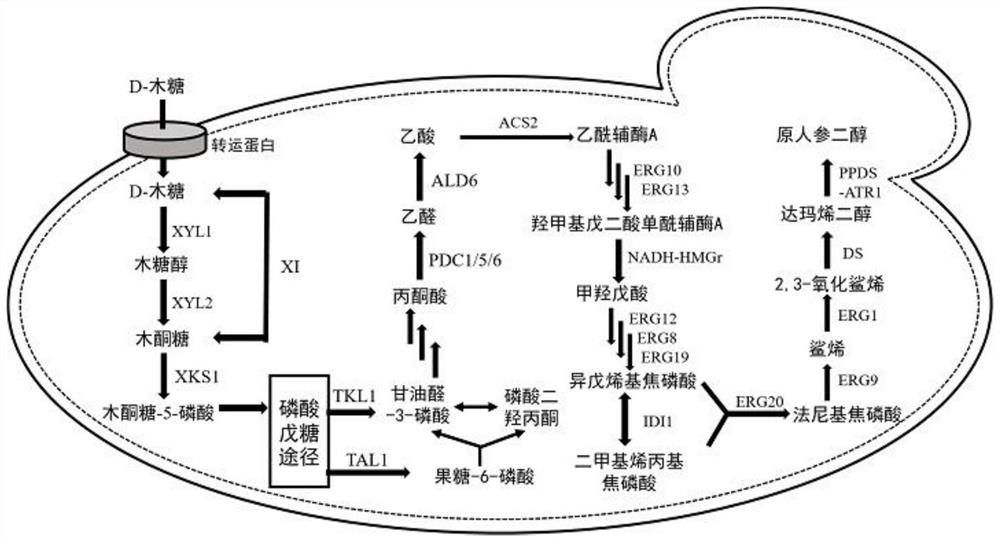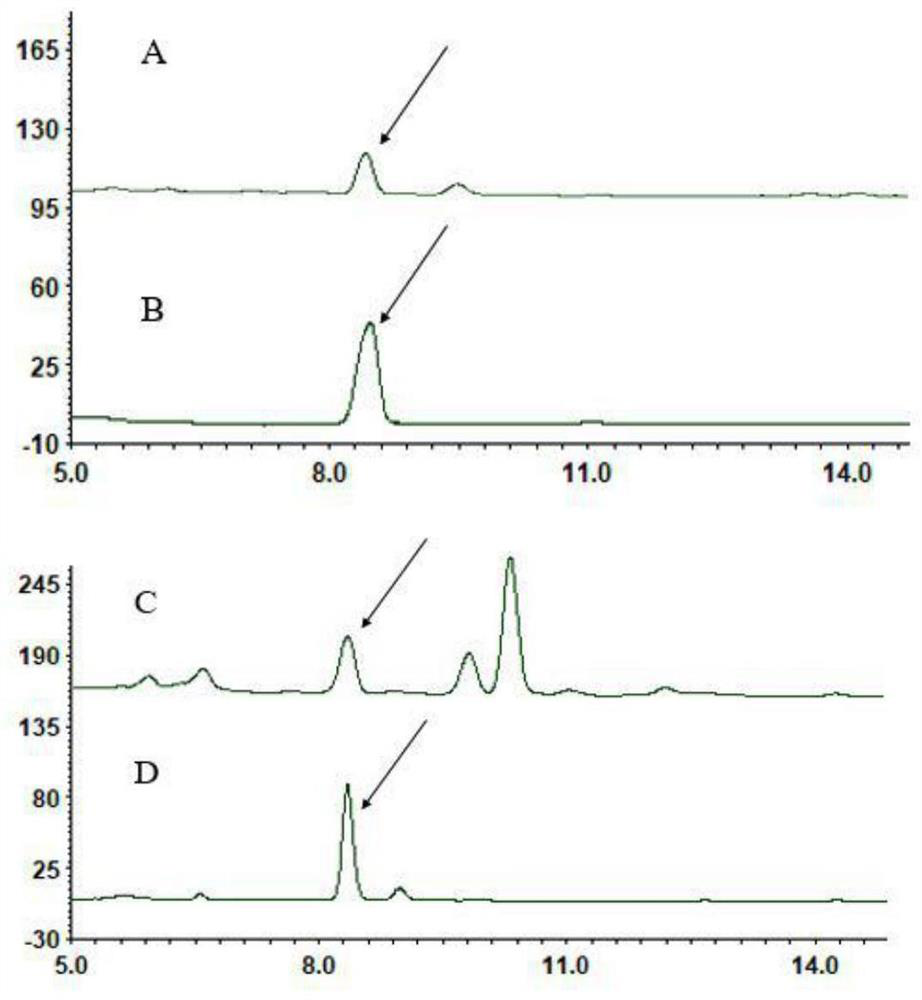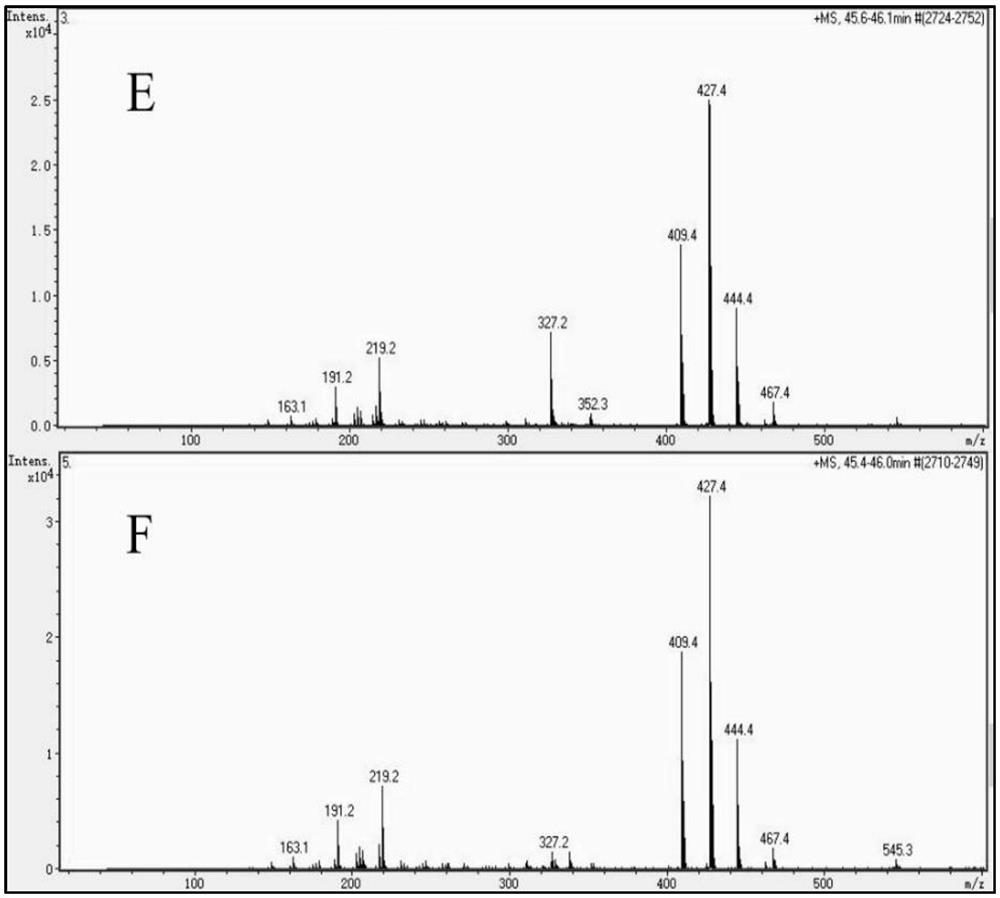Recombinant Saccharomyces cerevisiae and construction method for producing dammarenediol and protopanaxadiol using xylose
A technology of Saccharomyces cerevisiae and damarenediol, applied in the field of recombinant Saccharomyces cerevisiae and construction, and can solve problems such as low efficiency
- Summary
- Abstract
- Description
- Claims
- Application Information
AI Technical Summary
Problems solved by technology
Method used
Image
Examples
Embodiment 1
[0041] Embodiment 1, amplification and preparation of genetic elements
[0042] The xylulokinase XKS1 promoter is replaced by the promoter P FBA1 (Promoter P FBA1 ; Nucleotide sequence as shown in SEQ ID NO.1; simply marked as SEQ ID NO.1, the same below);
[0043] The expression cassette of the xylose reductase gene XYL1 is composed of a promoter P CCW12 (SEQ ID NO.15), xylose reductase gene XYL1 (SEQ ID NO.2) and terminator T HSP26 (SEQ ID NO.16) composition;
[0044] The xylitol dehydrogenase gene XYL2 expression cassette is composed of promoter P HXT7 (SEQ ID NO.17), xylitol dehydrogenase gene XYL2 (SEQ ID NO.3) and terminator T HXT7 (SEQ ID NO.18) composition;
[0045] The expression cassette of the transaldolase gene TAL1 is composed of a promoter P HXT7 , transaldolase gene TAL1 (SEQ ID NO.4) and terminator THXT7 composition;
[0046] The expression cassette of the transketolase gene TKL1 is controlled by the promoter P CCW12 , transketolase gene TKL1 (SEQ ID N...
Embodiment 2
[0073] Example 2 Transformation and Construction of Recombinant Saccharomyces cerevisiae Using Xylose to Produce Dammarenediol and Protopanaxadiol
[0074] DNA fragment XKS1t2-his3-P FBA1 -XKS1t1,P CCW12 -XYL1-T HSP26 ,P HXT7 -XYL2-T HXT7 ,P CCW12 -TKL1-T HSP26 and P HXT7 -TAL1-T HXT7 Import Saccharomyces cerevisiae to obtain recombinant strain 1;
[0075] DNA fragment P PGK1 -DS-T CYC1 P TEF1 -ERG1-T ADH1 and P TPI1 -ERG9-T ADH2 Introduce recombinant bacterium 1 to obtain recombinant bacterium 2;
[0076] DNA fragment P TPI1 -ERG20,P PGK1 -NADH-HMGr-T CYC1 and P TDH3 -PPDS-ATR1-T ADH1 Introducing the recombinant bacterium 2 to obtain the recombinant bacterium 3;
[0077] DNA fragment P HXT7 -ERG10, P PGK1 -ERG12 and P TEF1 -ERG13 was introduced into recombinant strain 3 to obtain recombinant strain 4.
[0078] The conversion method is as follows:
[0079] After Saccharomyces cerevisiae W303-1A was cultured in YPD medium for 12 hours, 300 μL was added ...
Embodiment 3
[0080] Example 3 Production of Dammarenediol and Protopanaxadiol by Fermentation of Recombinant Saccharomyces cerevisiae Using Xylose
[0081] Single colonies of recombinant bacteria 2, recombinant bacteria 3 and recombinant bacteria 4 were picked for shake flask fermentation. The fermentation conditions were 30° C., 220 rpm, and cultured for 3 days. Fermentation medium is YPX liquid medium, and wherein each component and final concentration thereof are as follows: final concentration is the xylose of 4% (mass percentage), the peptone of 2% (mass percentage), the yeast extract of 1% (mass percentage) powder, make up to volume with water.
[0082] After the fermentation is finished, extract with n-butanol, and the volume ratio of n-butanol to fermentation broth is 1:4. The n-butanol phase was taken for LC-MS detection, and it was found that recombinant bacteria 2 could produce 10.69 mg / L dammarene diol, and recombinant bacteria 3 could produce 3.17 mg / L dammarene diol and 11....
PUM
 Login to View More
Login to View More Abstract
Description
Claims
Application Information
 Login to View More
Login to View More - R&D
- Intellectual Property
- Life Sciences
- Materials
- Tech Scout
- Unparalleled Data Quality
- Higher Quality Content
- 60% Fewer Hallucinations
Browse by: Latest US Patents, China's latest patents, Technical Efficacy Thesaurus, Application Domain, Technology Topic, Popular Technical Reports.
© 2025 PatSnap. All rights reserved.Legal|Privacy policy|Modern Slavery Act Transparency Statement|Sitemap|About US| Contact US: help@patsnap.com



